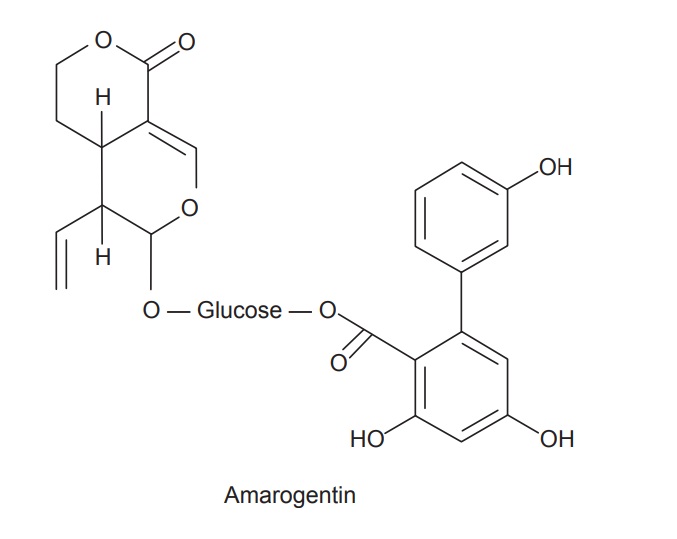Chirata
| Home | | Pharmacognosy |Chapter: Pharmacognosy and Phytochemistry : Drugs Containing Glycosides
Chirata consists of the entire herb of Swertia chirata Buch-Ham, belonging to family Gentianaceae. It contains not less than 1.3% bitter constituent.
CHIRATA
Synonyms
Indian Gentian, Indian Balmony, Chirayta, Ophelia chirata, Swertia chirayita.
Biological Source
Chirata consists of the entire herb of Swertia chirata Buch-Ham, belonging to family Gentianaceae. It
contains not less than 1.3% bitter constituent.
Geographical Source
It is mainly found in India, Nepal and Bhutan.
Characteristics
It is an annual, about 3 feet high; branching stem, Upper
part of the stem is yellow to brown, thinner and 2 mm broad. The lower part is
purplish or brown to dark brown; 6
broad cylindrical and exfoliated at some places showing dull
wood. Leaves are smooth entire, opposite, very acute, lanceolate dark brown
upto 8 cm long, 1.5–2 cm broad. Flowers numerous; peduncles yellow; one-celled
capsule. Rhizome is angular to 5 cm long, pale yellow to brown in colour and
covered with dense scale leaves. Root is primary, 5–10 cm long, light brown,
oblique somewhat twisted, tapering, longitudinally wrinkled and with transverse
ridges. Drug has no odour but taste is very bitter.

Microscopy
Root: 2–4 layers of cork; cortex region
consists of 4–12 layers of
thickwalled, parenchymataous cells with sinuous walls; secondary phloem
composed of thin walled sieve tubes, companion cells and phloem parenchyma;
secondary xylem composed of lignified and thick walled vessels, parenchyma,
tracheids and xylem fibres; minute acicular crystals present in abundance in
secondary cortex and phloem region; resin are also present as dark brown mass
in secondary cortex cells.
Leaf: single layered epidermis covered
with a thick, stri-ated cuticle and anisocytic stomata; single layered palisade
tissue below the upper epidermis, four to seven layers of loosely arranged
spongy parenchyma cells in messophyll, mucilage and minute acicular crystal are
present in mesophyll cells; parenchyma cells contain oil droplets also.
Stem: single layered epidermis, externally
covered with a thick striated cuticle
present in young stem, in older epidermis remains intact but cells flattened
and tangentially elongated; endodermis distinct, showing anticlinal or periclinal
walls, followed by single layered pericycle consisting of thin walled cells;
cambium, between external phloem and xylem composed of a thin strip of
tangentially elongated cells, internal phloem, similar in structure as that of
external phloem excepting that sieve tube strand is more widely separated;
xylem is continuous and composed mostly of tracheids, a few xylem vessels
present; vessels and fibre tracheids have mostly simple and bordered pits and
fibres with simple pits on the walls; medullary rays are absent; pith is
present in the central part consisting of rounded and isodiametric cells with
prominent intercellular spaces; acicular crystals, oil droplets and brown
pigments are also present.
Chemical Constituents
Chirata contains chiritin, gentiopicrin and amarogentin.
Amarogentin is phenol carboxylic acid ester of sweroside a substance related to
gentiopicrin. Ophelic acid a non crystal-line bitter substance is present. It
also contains gentianine and gentiocrucine.

Uses
It is an important ingredient in the well known ayurvedic
preparations Mahasudarshan churna and Sudarshan churna used successfully in
chronic fever. The whole plant is an extremely bitter tonic digestive herb that
lowers fevers and is stimulant. The herb has a beneficial effect on the liver,
promoting the flow of bile; it also cures constipation and is useful for
treating dyspepsia.
Marketed Products
It is one of the ingredients of the preparations known ad
Diabecon (Himalaya), Mehmudgar bati (Baidyanath), Sabaigo (Aimil Company), J.P.
Liver syrup (Jaumana Pharma), Fever end syrup (Chirayu), Sage Chirata (Sage
Herbals) and Safi (Hamdard Laboratories).
